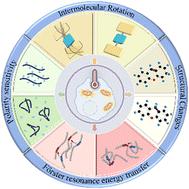当前位置:
X-MOL 学术
›
Anal. Methods
›
论文详情
Our official English website, www.x-mol.net, welcomes your feedback! (Note: you will need to create a separate account there.)
Response strategies and biological applications of organic fluorescent thermometry: cell- and mitochondrion-level detection
Analytical Methods ( IF 3.1 ) Pub Date : 2024-03-06 , DOI: 10.1039/d4ay00117f Shuai Li 1 , Yaoxuan Li 2 , Shiji Zhang 1 , Haixiao Fang 1, 3 , Ze Huang 1 , Duoteng Zhang 1 , Aixiang Ding 1 , Kajsa Uvdal 4 , Zhangjun Hu 4 , Kai Huang 3 , Lin Li 1, 3
Analytical Methods ( IF 3.1 ) Pub Date : 2024-03-06 , DOI: 10.1039/d4ay00117f Shuai Li 1 , Yaoxuan Li 2 , Shiji Zhang 1 , Haixiao Fang 1, 3 , Ze Huang 1 , Duoteng Zhang 1 , Aixiang Ding 1 , Kajsa Uvdal 4 , Zhangjun Hu 4 , Kai Huang 3 , Lin Li 1, 3
Affiliation

|
Temperature homeostasis is critical for cells to perform their physiological functions. Among the diverse methods for temperature detection, fluorescent temperature probes stand out as a proven and effective tool, especially for monitoring temperature in cells and suborganelles, with a specific emphasis on mitochondria. The utilization of these probes provides a new opportunity to enhance our understanding of the mechanisms and interconnections underlying various physiological activities related to temperature homeostasis. However, the complexity and variability of cells and suborganelles necessitate fluorescent temperature probes with high resolution and sensitivity. To meet the demanding requirements for intracellular/subcellular temperature detection, several strategies have been developed, offering a range of options to address this challenge. This review examines four fundamental temperature-response strategies employed by small molecule and polymer probes, including intramolecular rotation, polarity sensitivity, Förster resonance energy transfer, and structural changes. The primary emphasis was placed on elucidating molecular design and biological applications specific to each type of probe. Furthermore, this review provides an insightful discussion on factors that may affect fluorescent thermometry, providing valuable perspectives for future development in the field. Finally, the review concludes by presenting cutting-edge response strategies and research insights for mitigating biases in temperature sensing.
中文翻译:

有机荧光测温的响应策略和生物应用:细胞和线粒体水平检测
温度稳态对于细胞执行其生理功能至关重要。在多种温度检测方法中,荧光温度探针脱颖而出,是一种经过验证的有效工具,特别是用于监测细胞和亚细胞器的温度,特别是线粒体的温度。这些探针的利用提供了一个新的机会,以增强我们对与温度稳态相关的各种生理活动的机制和相互联系的理解。然而,细胞和亚细胞器的复杂性和可变性需要具有高分辨率和灵敏度的荧光温度探针。为了满足细胞内/亚细胞温度检测的苛刻要求,已经开发了多种策略,提供了一系列选项来应对这一挑战。这篇综述研究了小分子和聚合物探针采用的四种基本温度响应策略,包括分子内旋转、极性敏感性、福斯特共振能量转移和结构变化。主要重点是阐明每种类型探针的分子设计和生物学应用。此外,这篇综述对可能影响荧光测温的因素进行了深入的讨论,为该领域的未来发展提供了宝贵的视角。最后,综述提出了缓解温度传感偏差的前沿响应策略和研究见解。
更新日期:2024-03-06
中文翻译:

有机荧光测温的响应策略和生物应用:细胞和线粒体水平检测
温度稳态对于细胞执行其生理功能至关重要。在多种温度检测方法中,荧光温度探针脱颖而出,是一种经过验证的有效工具,特别是用于监测细胞和亚细胞器的温度,特别是线粒体的温度。这些探针的利用提供了一个新的机会,以增强我们对与温度稳态相关的各种生理活动的机制和相互联系的理解。然而,细胞和亚细胞器的复杂性和可变性需要具有高分辨率和灵敏度的荧光温度探针。为了满足细胞内/亚细胞温度检测的苛刻要求,已经开发了多种策略,提供了一系列选项来应对这一挑战。这篇综述研究了小分子和聚合物探针采用的四种基本温度响应策略,包括分子内旋转、极性敏感性、福斯特共振能量转移和结构变化。主要重点是阐明每种类型探针的分子设计和生物学应用。此外,这篇综述对可能影响荧光测温的因素进行了深入的讨论,为该领域的未来发展提供了宝贵的视角。最后,综述提出了缓解温度传感偏差的前沿响应策略和研究见解。



























 京公网安备 11010802027423号
京公网安备 11010802027423号